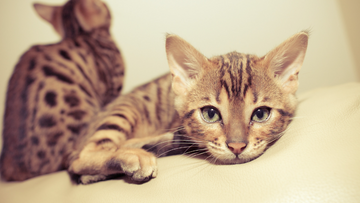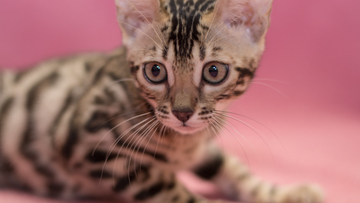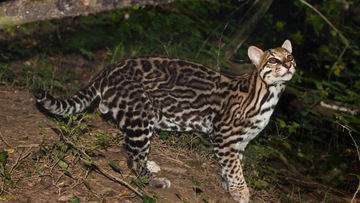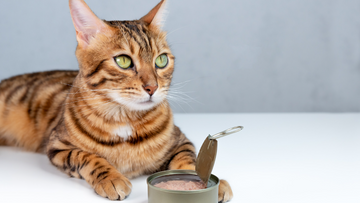Tica Bengal Standard
GENERAL DESCRIPTION
Loved by those who appreciate its inquisitive and loving nature, the Bengal is a medium to large cat renowned for its richly colored, highly contrasted coat of vivid spots or distinctive marbling. Originally developed from crosses between the domestic cats and the Asian Leopard Cat, the Bengal is the only domestic cat that can have rosettes like the markings on Leopards, Jaguars and Ocelots. Today's domestic Bengal cat comes only from breeding Bengals to other Bengals and requires no specialized care. Since their beginnings in 1986, the Bengal's regal beauty and alluring charm have quickly made it one of the most popular breeds. Employing scientific insights and a cooperative spirit, Bengal breeders continue to develop these stunning cats with careful selection for temperament, health and beauty. Bengals participate in TICA shows throughout the world and have a devoted following of happy pet owners who couldn't imagine sharing their lives with anything other than these feline beauties.
B E N G A L B R E E D G R O U P (BG/BGL)
HEAD . . . . . . . . . . . . . . . . . . . . . 35 points
Shape ................. 6
Ears. . . . . . . . . . . . . . . . . . . 6
Eyes . . . . . . . . . . . . . . . . . . 5
Chin. . . . . . . . . . . . . . . . . . . 3
Muzzle. . . . . . . . . . . . . . . . . 4
Nose . . . . . . . . . . . . . . . . . . 2
Profile . . . . . . . . . . . . . . . . . 6
Neck . . . . . . . . . . . . . . . . . . 3
BODY. . . . . . . . . . . . . . . . . . . . . 30 points
Torso. . . . . . . . . . . . . . . . . . 5
Legs . . . . . . . . . . . . . . . . . . 4
Feet. . . . . . . . . . . . . . . . . . . 4
Tail . . . . . . . . . . . . . . . . . . . 5
Boning. . . . . . . . . . . . . . . . . 6
Musculature . . . . . . . . . . . . 6
COAT/COLOR/PATTERN . . . . . 35 points
Texture . . . . . . . . . . . . . . . 10
Pattern . . . . . . . . . . . . . . . 15
Color . . . . . . . . . . . . . . . . . 10
CATEGORIES: All.
DIVISION: Tabby, Silver/Smoke.
COLORS: Brown Tabby, Seal Sepia Tabby, Seal Mink Tabby, Seal Lynx Point, Black Silver Tabby, Seal Silver Sepia Tabby, Seal Silver Mink Tabby, Seal Silver Lynx Point.
Spotted or Marbled Patterns ONLY.
PERMISSIBLE OUTCROSSES: None.
HEAD:
BG Shape: Broad modified wedge with rounded contours. Longer than it is wide. Slightly small in proportion to body, but not to be taken to extreme. The skull behind the ears makes a gentle curve and flows into the neck. Allowance to be made for jowls in adult males. Overall look of the head should be as distinct from the domestic cat as possible.
BGL Shape: Broad modified wedge with rounded contours. Longer than it is wide. Slightly small in proportion to body, but not to be taken to extreme. The skull behind the ears makes a gentle curve and flows into the neck. Allowance to be made for jowls in adult males. Feathering behind the ears and into ruff, giving a frontal effect of roundness framing the head is desirable. A mane is acceptable but not required. Overall look of the head should be as distinct from the domestic cat as possible.
BG Ears: Medium to small, relatively short, with wide base and rounded tops. Set as much on side as top of head, following the contour of the face in the frontal view, and pointing forward in the profile view. Light horizontal furnishings acceptable; lynx tipping undesirable.
BGL Ears: Medium to small, relatively short, with wide base and rounded tops. Set as much on side as top of head, following the contour of the face in the frontal view, and pointing forward in the profile view.
Horizontal furnishings are desirable. Lynx tipping is permissible. Eyes: Oval, almost round. Large, but not bugged. Set wide apart, back into face,
and on slight bias toward base of ear. Eye color independent of coat color except in the lynx points. The more richness and depth of color the better.
Chin: Strong chin, aligns with tip of nose in profile. Muzzle: Full and broad, with large, prominent whisker pads and high, pronounced cheekbones. Slight muzzle break at the whisker pads.
Nose: Large and wide; slightly puffed nose leather.
Profile: Curve of the forehead should flow into the bridge of the nose with no break. Bridge of nose extends above the eyes; the line of the bridge extends to the nose tip, making a very slight, to nearly straight, concave curve.
Neck: Long, substantial, muscular; in proportion to the head and body.
BODY:
Torso: Long and substantial, not oriental or foreign. Medium to large (but not quite as large as the largest domestic breed).
BG Legs: Medium length, slightly longer in the back than in the front.
BGL Legs: Medium length, slightly longer in the back than in the front. Britches should be medium to short. Toe hair is acceptable.
Feet: Large, round, with prominent knuckles.
BG Tail: Medium length, thick, tapered at the end with a rounded tip.
BGL Tail: Medium length, thick, tapered at the end with a rounded tip. The tail hair should be long and voluminous. Allowance for shorter tail hair in kittens.
Boning: Sturdy, firm; never delicate.
Musculature: Very muscular, especially in the males, one of the most distinguishing features.
Revised 05//01/17 Bengal Breed Group Standard, 05/01/2017
COAT/COLOR/PATTERN:
BG Length: Short to medium. Allowance for slightly longer coat in kittens.
BGL Length: The coat should be medium to long in length lying close to the body, with furnishings. Allowance for slightly shorter coat in kittens.
Texture: Dense and luxurious, closelying, unusually soft and silky to the touch.
Patterns: Spotted or marbled.
Spotted: Spots shall be random, or aligned horizontally. Rosettes showing two distinct colors or shades, such as paw print shaped, arrowhead shaped, doughnut or half-doughnut shaped or clustered are preferred to single spotting but not required.Contrast with ground color must be extreme, giving distinct pattern and sharp edges. Strong, bold chin strap and mascara markings desirable. Virtually white undersides and belly desirable. Blotchy horizontal shoulder streaks, spotted legs and spotted or rosetted tail are desirable. Belly must be spotted.
Marbled: See TICA Uniform Color Description (74.1.1.2.1).
Colors:
Brown Tabby: All variations of brown are allowed. Markings various shades of brown to black. Light spectacles encircling the eyes and a virtually white ground color on the whisker pads, chin, chest, belly and inner legs is desirable.
Seal Sepia Tabby, Seal Mink Tabby, and Seal Lynx Point Tabby: Pattern can be various shades of brown. There should be very little or no difference between the color of the body (pattern) markings and point color.
GENERAL: The goal of the Bengal breeding program is to create a domestic cat which has physical features distinctive to the small forest-dwelling wildcats, and with the loving, dependable temperament of the domestic cat. Keeping this goal in mind, judges shall give special merit to those characteristics in the appearance of the Bengal which are distinct from those found in other domestic cat breeds. A Bengal cat is an athletic animal, alert to its surroundings; a friendly, curious, confident cat with strength, agility, balance and grace. It is a medium to large cat which exhibits a very muscular and solid build. Its wide nose with prominent whisker pads and large oval, almost round eyes in a slightly small head enhance the wild appearance and expressive nocturnal look. Its very slight, to nearly straight, concave profile and relatively short ears with wide base and rounded tips add to the Bengal’s distinctive and unique appearance. The short, dense coat has a uniquely soft and silky feel. The coat may be glittered or not glittered, with neither type to be given preference. A thick, low-set, medium-length tail adds balance to the cat.
ALLOWANCES: Smaller size, in balanced proportion, of females. Slightly longer coat in kittens. Jowls in adult males. Eyes slightly almond shaped. Mousy undercoat. Paw pads not consistent with color group description.
PENALIZE: Spots on body running together vertically forming a mackerel tabby pattern on spotted cats; circular bulls-eye pattern on marbled cats; substantially darker point color (as compared to color of body markings) in Seal Sepia, Seal Mink, or Seal Lynx Point cats. Any distinct locket on the neck, chest, abdomen or any other area.
WITHHOLD ALL AWARDS (WW): Belly not patterned.
– – – – –
Temperament must be unchallenging; any sign of definite challenge shall disqualify. The cat may exhibit fear, seek to flee, or generally complain aloud but may not threaten to harm. In accordance with Show Rules, ARTICLE SIXTEEN, the following shall be considered mandatory disqualifications: a cat that bites (216.9), a cat showing evidence of intent to deceive (216.10), adult whole male cats not having two descended testicles (216.11), cats with all or part of the tail missing , except as authorized by a board approved standard (216.12.1), cats with more than five toes on each front foot and four toes on each back foot, unless proved the result of an injury or as authorized by a board approved standard (216.12.2), visible or invisible tail faults if Board approved standard requires disqualification (216.12.4), crossed eyes if Board approved standard requires disqualification (216.12.5), total blindness (216.12.6), markedly smaller size, not in keeping with the breed (216.12.9), and depression of the sternum or unusually small diameter of the rib cage itself (216.12.11.1).
See Show Rules, ARTICLE SIXTEEN for more comprehensive rules governing penalties and disqualifications.






